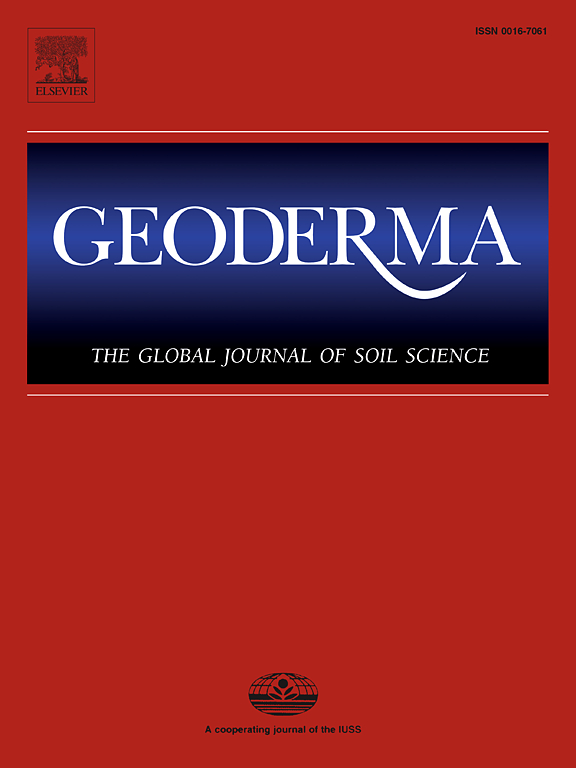Combining temperature ramp dry combustion and mid-infrared spectroscopy for enhanced soil organic carbon characterisation
IF 5.6
1区 农林科学
Q1 SOIL SCIENCE
引用次数: 0
Abstract
Soil organic carbon (SOC) is comprised of a complex mixture of plant and microbial-derived compounds with varying chemical compositions and stability. Understanding these components is crucial for modelling SOC turnover and stability. Conventional fractionation methods moslty use physical or chemical separations, but techniques such as mid-infrared (MIR) spectroscopy and thermal ramp dry combustion (TRDC) offer complementary, rapid approaches for SOC characterisation. This study integrates MIR spectroscopy and TRDC to characterise plant-derived compounds in soils. Using soils dosed with six plant-derived compounds (cellulose, lignin, starch, pectin, xylose, and biochar), we investigated their thermograms and MIR spectra. Each compound exhibited unique thermal decomposition peaks and MIR absorptions, reflecting their distinct chemical structures and oxidative stability. Correlation analyses revealed strong relationships between thermal peaks and MIR features. Models that combined MIR and TDRC spectra could estimate cellulose (), biochar (), pectin () and starch (). Our findings show the potential for combining MIR spectroscopy and TRDC to characterise SOC chemical composition. By identifying distinct thermal and spectral features of plant-derived compounds, the combined approach could identify contributions of plant-derived compounds to labile and stable carbon pools, for enhancing our understanding of SOC decomposability. These methods may provide new insights into SOC turnover and stability mechanisms when applied to fractionated soils.
结合温度斜坡干燃烧和中红外光谱增强土壤有机碳表征
土壤有机碳(SOC)是由植物和微生物衍生的化合物组成的复杂混合物,具有不同的化学成分和稳定性。了解这些组件对于模拟SOC的周转和稳定性至关重要。传统的分馏方法大多使用物理或化学分离,但中红外(MIR)光谱和热斜坡干燃烧(TRDC)等技术为SOC表征提供了补充、快速的方法。本研究整合了MIR光谱和TRDC来表征土壤中的植物衍生化合物。我们使用含有六种植物衍生化合物(纤维素、木质素、淀粉、果胶、木糖和生物炭)的土壤,研究了它们的热图和MIR光谱。每种化合物都具有独特的热分解峰和MIR吸收,反映了它们独特的化学结构和氧化稳定性。相关分析显示热峰与MIR特征之间有很强的相关性。结合MIR和TDRC光谱的模型可以估计纤维素(ρc=0.92)、生物炭(ρc=0.95)、果胶(ρc=0.77)和淀粉(ρc=0.87)。我们的发现显示了结合MIR光谱和TRDC来表征SOC化学成分的潜力。通过识别植物源性化合物不同的热光谱特征,该方法可以识别植物源性化合物对稳定碳库和不稳定碳库的贡献,从而提高我们对有机碳分解能力的认识。这些方法可为研究分馏土壤有机碳的转换和稳定性机制提供新的见解。
本文章由计算机程序翻译,如有差异,请以英文原文为准。
求助全文
约1分钟内获得全文
求助全文
来源期刊

Geoderma
农林科学-土壤科学
CiteScore
11.80
自引率
6.60%
发文量
597
审稿时长
58 days
期刊介绍:
Geoderma - the global journal of soil science - welcomes authors, readers and soil research from all parts of the world, encourages worldwide soil studies, and embraces all aspects of soil science and its associated pedagogy. The journal particularly welcomes interdisciplinary work focusing on dynamic soil processes and functions across space and time.
 求助内容:
求助内容: 应助结果提醒方式:
应助结果提醒方式:


